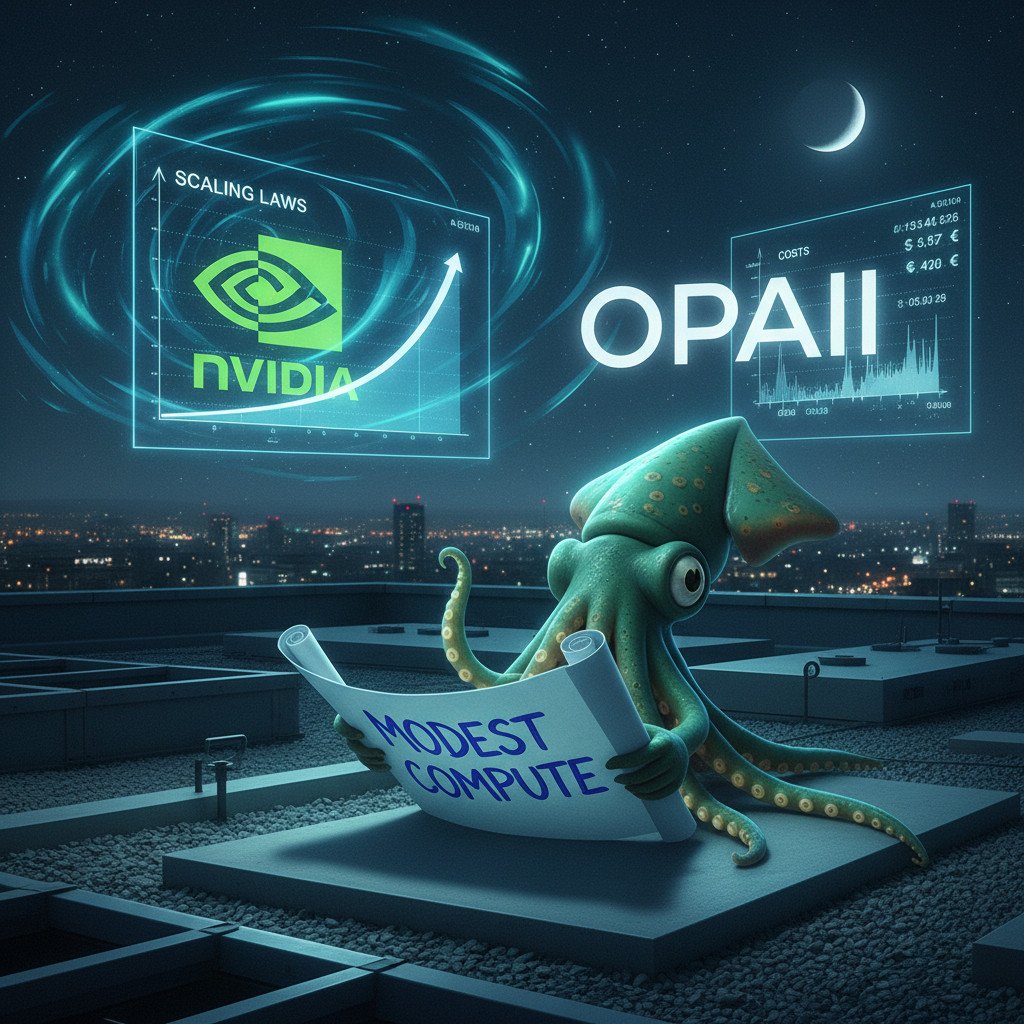Introduction
The AI scaling obsession drives massive investment in compute, chips, and data centers worldwide. Companies pour billions into GPUs and custom silicon to chase frontier models and higher performance. However, this frenzy now sits at the intersection of technical ambition and real world limits. As a result, sustainability and cost concerns jump to the top of industry agendas.
Recent research, including an MIT study on scaling laws, shows diminishing returns for huge models. Therefore, modest compute models and efficiency gains can often deliver similar results. Because energy and training costs rise quickly, organizations face hard trade offs. This dynamic forces a rethink of priorities from pure scale to smarter algorithms and chips.
OpenAI, DeepSeek, and big tech now juggle infrastructure bets with product demand and supply chains. Moreover, about 60 percent of data center costs go toward GPUs, which matters for budgets. If unchecked, the build out risks crowding out fringe ideas like alternative architectures and quantum research. Therefore, this article examines the risks of excessive scale and how efficiency can change the path forward.
We will weigh environmental, financial, and technical cliffs ahead, with a cautious, analytical lens. In particular, we consider how scaling laws, GPUs, and data center economics shape AI’s future. Finally, we suggest practical moves that researchers and leaders can take to avoid costly dead ends. Read on to understand why balancing scale and efficiency matters now more than ever.
Challenges of the AI scaling obsession
The AI scaling obsession pushes firms to expand AI infrastructure faster than they can adapt. Because companies rush to add GPUs and custom chips, operational complexity grows quickly. Moreover, the MIT-backed analysis covered in Wired warns of diminishing returns from pure scale. Therefore, leaders must weigh compute gains against shrinking performance improvements and rising costs. For context on infrastructure bets, see OpenAI’s move to develop custom chips with Broadcom for more compute capacity Wired, AP News.
Businesses face several clear challenges as a result. Below are the main pain points that stem from scaling risks, automation challenges, and stretched AI infrastructure:
- Concentration of capital and vendor lock in increases cost exposure. GPUs make up most data center expenses, and this concentrates buying power.
- Rising operational complexity makes deployments harder to manage. Consequently, teams need new skills for orchestration, cooling, and maintenance.
- Automation challenges emerge as more custom tooling is required. Therefore, pipelines break more often and require deeper engineering.
- Sustainability and energy costs balloon with scale. As a result, carbon footprints and utility bills climb alongside compute demand.
- Diminishing returns reduce the case for ever-larger models. Thus, efficiency gains can sometimes beat sheer scale in cost effectiveness.
- Innovation crowding occurs when big infrastructure bets drown out fringe research. For example, alternative architectures and quantum work may get less funding.
- Regulatory and risk management burdens increase with system complexity. Consequently, compliance teams face harder audits and safety checks.
In short, the drive to scale creates trade offs across finance, operations, and strategy. Businesses must balance short-term product demand with long-term efficiency and innovation goals. Otherwise, firms risk costly technical cliffs and stalled progress.

Image shows abstract visual elements representing three bottlenecks: data handling, compute limits, and infrastructure constraints. The composition uses colored data streams, stacked chip tiles, and simplified server racks with cooling waves to illustrate scaling pressures without text.
Innovative solutions to the AI scaling obsession
The AI scaling obsession has pushed companies to explore smarter, not just larger, pathways. As a result, leaders now pair cloud scaling with machine learning optimization to cut costs and emissions. For example, researchers cite efficiency gains and alternatives to brute force scaling in recent studies, including the MIT analysis of scaling laws and model efficiency improvements arXiv paper.
Hardware and software co design reduces waste and improves throughput. Therefore, firms invest in custom accelerators and chip design partnerships to squeeze more performance per watt. OpenAI’s Broadcom collaboration illustrates this trend, because it aims to tailor hardware to model needs and reduce vendor lock in AP News.
Algorithmic efficiencies matter more than ever. For example, techniques like pruning, quantization, and knowledge distillation shrink models while preserving accuracy. Consequently, smaller models perform competitively with far less compute. Moreover, mixture of experts and sparse models lower inference costs by activating only needed sub networks.
Cloud scaling and smarter orchestration help teams manage variable demand. Firms use autoscaling groups, spot instances, and serverless inference to match resources to traffic. As a result, operational costs fall and utilization improves. Additionally, AI automation pipelines now include cost aware schedulers and data caching to avoid redundant compute.
Data centric practices and machine learning optimization complement model techniques. Therefore, teams prioritize curated data, active learning, and transfer learning to boost signal per example. In doing so, they cut training time and energy use. Federated learning and edge AI also reduce central compute needs by shifting some workloads to devices.
Sustainability and governance tie these approaches together. For instance, energy aware training schedules and carbon tracking tools make scaling choices visible and accountable. Furthermore, investing a portion of budgets into algorithmic research can offset diminishing returns from sheer scale. Finally, blending cloud scaling, hardware innovation, and smarter models offers a balanced path forward for firms wrestling with scaling risks and automation challenges.
Comparing AI scaling approaches
Below is a concise table comparing common AI scaling methodologies. It highlights cost efficiency, speed, complexity, and scalability potential.
| Approach | Cost efficiency | Speed | Complexity | Scalability potential |
|---|---|---|---|---|
| Vertical scaling | Low at large scale; expensive high end hardware | High single node throughput | Lower software complexity; higher hardware management | Limited by single node ceilings |
| Horizontal scaling | Generally cost effective for growth | High parallel throughput across nodes | Requires distributed systems engineering and orchestration | High, but overhead rises with scale |
| Cloud based scaling | Variable; pay as you go reduces upfront spend | Fast provisioning; subject to network limits | Lower infra ops but introduces vendor dependency | Very high; effectively on demand |
| Hybrid scaling | Balances capital and operational costs | Can combine low latency and elastic capacity | Integrating cloud and on premise systems adds complexity | High if well orchestrated and governed |
Consider workload patterns, budget, and sustainability when choosing. For example, model training favors horizontal or cloud scale. Conversely, low latency inference may call for vertical or hybrid deployments.
Business impact of the AI scaling obsession
The AI scaling obsession reshapes company performance and market advantage. Because firms invest heavily in AI infrastructure, they secure faster automation and quicker product cycles. For example, automation can accelerate routine workflows and improve decision speed. Moreover, firms that harness scale well can ship features faster than rivals.
However, the same rush creates real financial risk. About 60 percent of data center costs go toward GPUs, which raises capital and operating expenses. Therefore, overspending on hardware can erode margins and slow returns. As a result, some organizations face budget shock when models underdeliver for the cost.
Operationally, scale improves resilience when teams automate ops and monitoring. Consequently, companies can maintain uptime and handle peak loads. Yet rapid scaling also increases system complexity and failure modes. For instance, custom stacks and vendor lock in raise the risk of cascading outages.
Experts warn about narrowing returns from pure scale. Neil Thompson argues that improvements may narrow in the next decade, and that efficiency matters more than raw compute. See the MIT scaling analysis for details on diminishing returns and model efficiency here. Furthermore, OpenAI’s push for custom chips shows how firms hedge supply risks and optimize performance here.
Strategically, scale yields clear advantages when paired with good governance. Therefore, leaders who blend model efficiency, cost control, and carbon tracking gain more sustainable edge. Moreover, investing in algorithmic research and data quality can multiply returns without more compute.
Still, the AI scaling obsession can crowd out alternative innovation. Consequently, fringe research in novel chips and quantum approaches may see less funding. Finally, the right balance between scale and efficiency creates durable competitive advantage. Thus companies should measure outcomes, not just compute, when they plan expansion.

Abstract visual symbol of AI driven business growth showing an ascending arrow formed by glowing network nodes and subtle chip circuit patterns. The image uses a teal to deep blue gradient and soft glows to convey momentum and optimism without any text.
Best practices for managing the AI scaling obsession
Managing the AI scaling obsession requires discipline, metrics, and clear priorities. First, establish a governance framework that sets budget caps and performance targets. Therefore, leaders can avoid runaway infrastructure spend and keep projects aligned with business value.
Adopt measurable scaling management practices. For example, track cost per training run and cost per inference. Moreover, add utilization metrics and carbon intensity for each project. Consequently, teams see trade offs between performance, cost, and sustainability.
Optimize AI infrastructure with a rightsizing mindset. Use cloud scaling and spot instances to cut costs during nonpeak hours. Additionally, mix on premise and cloud resources to balance latency and elasticity. For reference, industry groups recommend energy aware scheduling and carbon tracking to guide operations (arXiv study on scaling laws).
Invest in machine learning optimization and automation efficiency. Prioritize techniques like pruning, quantization, and knowledge distillation. As a result, smaller models deliver strong accuracy with far less compute. Also, automate cost aware schedulers and model profiling in MLOps pipelines to prevent waste.
Build multidisciplinary teams for AI infrastructure optimization. Include ML researchers, SREs, and sustainability specialists. Therefore, you avoid siloed decisions that favor scale over efficiency. Also, encourage experiments that compare modest compute models against frontier models.
Follow these operational best practices:
- Define clear success metrics such as latency, accuracy, cost per token, and carbon per training hour
- Implement autoscaling and intelligent routing to match capacity with demand
- Use spot instances and reserved capacity where it lowers cost effectively
- Establish vendor diversification to reduce supplier risk and vendor lock in
- Fund a percentage of budgets for algorithmic research and efficiency work
- Enforce staging environments, canary releases, and automated rollback plans
Finally, embed sustainability and auditability into every stage. For instance, keep reproducible experiments and maintain a model card inventory. Moreover, communicate trade offs to stakeholders to align strategy with long term goals. In doing so, companies can tame the AI scaling obsession while preserving competitiveness and avoiding costly technical cliffs.
Conclusion
The AI scaling obsession forces companies to prioritize efficiency over blind growth. Research shows that bigger models can hit diminishing returns. Therefore, firms must balance compute, cost, and sustainability.
Rapid scaling brings clear benefits like faster automation and quicker innovation cycles. However, overspending and complex stacks create failure risks. As a result, leaders should pair cloud scaling with model and data optimization. In doing so, teams reduce cost per inference and lower their carbon footprint.
Strategic scaling focuses on measurable outcomes, not just raw compute. For example, rightsizing infrastructure, investing in pruning and quantization, and using spot instances improve margins. Moreover, multidisciplinary teams help align ML research with operations and governance.
EMP0, Employee Number Zero, LLC, stands out as a practical partner for this work. The company offers sales and marketing automation that ties AI workers directly to revenue. Also, EMP0 delivers full stack AI workers that handle data, model orchestration, and routine tasks. Therefore, businesses can adopt AI safely while preserving agility and cost control.
In short, tame the AI scaling obsession with strategy, metrics, and smarter tech choices. Finally, invest in efficiency and governance to gain durable advantage. Companies that do will scale sustainably and avoid costly technical cliffs.

